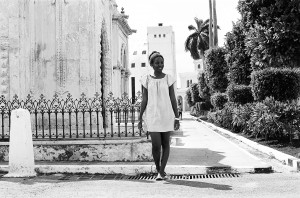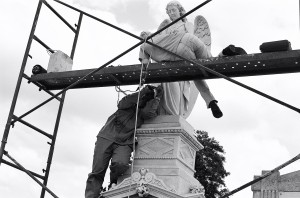Cementerio de Cristóbal Colón: tourist mobillity and and a contingent immobility
April 13, 2012 by jobleckner
Typically, one wouldn’t consider a cemetery to be a tourist sight, but our group of ‘responsible’ ‘academic’ tourists arrived at el Cementerio de Cristóbal Colón in Vedado, La Habana on our tour bus. The cemetery was 140 acres; it was so big that the cemetery was laid out in a grid system with street numbers. Although we were visiting a ‘city of dead’, the thousands of white stone memorials that had been weathered by the tropical weather were extremely aesthetically intriguing. I began taking tons of photographs, too occupied with the spectacle of the location rather than its sensitive function as a house for deceased loved ones and national heroes. I even ended up taking a portrait of a fellow student, which only now in retrospect seems absurd. But, at the time, my eyes were glued to my camera, which created a lens that further removed me from the actual site.
 Portrait of student in Cemetery.
Portrait of student in Cemetery.
While touring the cemetery, we saw two restorers repairing a beautiful memorial. I began to wonder what the reason was for restoring these memorials. Was the purpose of the restoration to enhance the spectacle of the cemetery (i.e. attract more tourists)? Was there an inherent cultural importance in restoring grave stones? Although I became a bit skeptical upon witnessing the restorers, I continued to take photographs like any tourist.
The most uncomfortable moment of the tour embodied a certain guilt for me that would remain indelible throughout the rest of our group’s trip. As our passionate tour guide was telling a story in his distinctly resonate voice about Amelia la Milagrosa, a funeral procession passed by. However, our tour guide disregarded the procession and continued to tell his story. This moment supports a sociological theory that I read about in Mimi Sheller’s book, “Consuming the Caribbean”. Sheller posits, “The apparent freedom of movement and boundless travel in a ‘world without frontiers’ is produced by the techniques of binding people, places, and meanings in place.” In other words, our increased mobility as tourists necessitates a degree of immobility for locals. Our presence with our extremely loud tour guide created a hindrance for the procession; the mourning family and friends were interrupted by our presence. From that moment on, the implications of our mobility in Cuba as tourist became more apparent.
When I told my brother, who has been to Cuba as well, about my experience at the cemetery, he also had experienced an odd moment that illustrated the tension between the tourist sight and the cultural site. He was walking around the cemetery when an employee asked him if he wanted to see human bones. My brother agreed, somewhat in disbelief. He followed the cemetery employee to the main chapel and they descended into a room in the basement. My brother watched the employee walk across a room completely covered in bones, crunching peoples femurs and fibulae. The employee picked up a lower jaw bone and tosses it to my brother who was standing uncomfortably on the perimeter of the room. He was holding part of a human skull. I believe our anecdotes at the Cementerio de Cristóbal Colón reflect the invasiveness of the mobility of tourism.
Sources
“Consuming the Caribbean”. Mimi Sheller
Colon Cemetery, Havana. Wikipedia page.
Leave a Reply
You must be logged in to post a comment.
